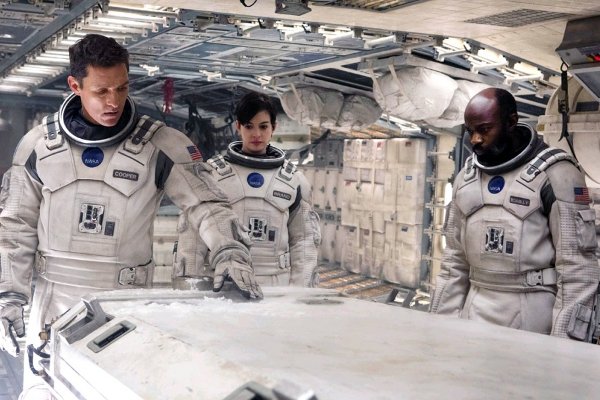The Science of Interstallar: Chapter II. Gargantua (Chapter 6. Gargantua's anatomy)
The Science of Interstellar: Chapter II. Gargantua
Chapter 6. Gargantua's anatomy
Title: Interstellar
Director: Christopher Nolan
Cast: Matthew McConaughey, Anne Hathaway, Jessica Chastain, Matt Daymon
Genre: Science Fiction, Dystopia, Documentary, Action, Adventure
Language: English
Rated PG-13
Running time: 169 minutes
My Rating: 9.9/10
According to Einstein’s relativistic laws, we can deduce all the properties of a black hole such as its size, the strength of its gravitational pull, how much its event horizon is stretched outward near the equator by centrifugal forces, or the details of the gravitational lensing, etc. Basically everything by only knowing the mass of a black hole and how fast it spins! Isn't that fascinating? Black holes' mass, gravitational pull, lensing, velocity, etc. are all mathematically connected!
Gargantua's Mass
Before we talk about the specific features of Gargantua, I will introduce basic laws regarding black hole's physical properties.
First, the strength of this stretch and squeeze is inversely proportional to the square of a black hole’s mass. Why? The greater the mass, the greater its circumference, and therefore the more similar Gargantua’s gravitational forces are on the various parts of the planet, which results in weaker tidal forces.
Second, the circumference of a black hole’s event horizon is proportional to the hole’s mass.
Based on these laws, Kip Thorne, the author of this book, a Nobel Prize Winner in 2017, and an expert on black holes and wormholes, who helped Christopher Nolan to design Gargantua states that
- The mass of Gargangua is about the mass of 200 million suns
- The horizon circumference of Gargantua is about the earth’s orbit around the sun (approx. 1 billion km)
Gargantua’s spin
In the movie, we are introduced that 1 hour on Miller’s planet is 7 years on Earth
(by the way, here is a funny meme about this concept)
Interestingly, Kip Thorne confessed in his book that it is theoretically possible and told Christopher Nolan that it is "non-negotiable." Thankfully, he later figured out that to make this scenario possible, 2 conditions should be met:
-
Miller’s planet is about as near Gargantua as it can get without falling in
-
Gargantua is spinning fast enough. Almost as fast as the maximum (but less than the maximum. It is actually maximum minus 0.00000000000001).
If the spinning is greater than the maximum, its horizon will disappear, only leaving the singularity inside it wide open for all the universe to see.

The crew of the Endurance could measure the spin rate by watching from far away as the robot TARS falls into Gargantua. TARS never crosses the horizon (if it does, the signals he sends can’t get out of the hole). Instead, TARS’ infall appears to slow down, and he appears to hover just above the horizon.
Mathematically calculating the speed of TARS using the orbital distance and the time taken, we can figure out that TARS's speed is approximately the speed of light.
If Gargantua were spinning faster than the maximum, TARS would whip around faster than the speed of light - which violates Einstein’s speed limit (!!!). This is why there is a maximum possible spin for a black hole.
Fortunately, there is a mechanism by which Nature protects Black holes from spinning faster than the maximum! (yay we can have more black holes existing in the universe)
- When a black hole's speed gets closer to the maximum spin, a black hole has difficulty capturing objects that orbit in the same direction as the hole rotates. Thus, when captured, the hole’s spin increases.
- But, the hole easily captures things that orbit opposite to its spin and that, when captured, slow the hole’s spin. Thus, the spin is easily slowed when it gets close to the maximum.
- Kip Throne introduced an example in the book: an accretion disk and a black hole. When the hole’s spin reaches 0.998 of the max, an equilibrium is reached, with spin-down by the captured photons precisely counteracting spin-up by the accreting gas.
Gargantua’s external anatomy
Because Gargantua’s spin is much closer to the possible maximum, Gargantua’s throat is far longer. It extends much farther downward before reaching the horizon.
However, at this distance (parking orbit), Gargantua would subtend about 50 degrees on the Endurance’s sky. So the team chose to make Gargantua look much smaller at the parking orbit, around two and a half degrees.
Here is the overall external anatomy of Gargantua that I made!
(Please click the image to view the high-quality image)
Do you see the part about the shell of fire?
In fact, the nearly trapped but escaping photons have a big impact on Gargantua’s visual appearance in Interstellar. They mark the edge of Gargantua’s shadow as seen by the Endurance’s crew, and they produce a thin bright line along the shadow’s edge.
Behold the intricacies of Gargantua, a celestial marvel that defies randomness in its design. This cosmic giant isn't a mere product of chance; it unfolds with deliberate structure and visual precision, a manifestation that aligns seamlessly with the principles of physics. Yet, there's an enchanting blend of creativity that transcends strict realism. It's more than a graphic representation; it's a meticulously "architectured" entity, a product of profound mathematical calculations that breathe life into its form.
In the upcoming post, prepare to delve into the captivating realm of gravitational slingshots! Join me on a journey through the intricate science of Interstellar, where the forces that shape our cosmic landscape are unveiled in all their fascinating glory. Stay tuned for another cosmic adventure! 💫


Comments
Post a Comment